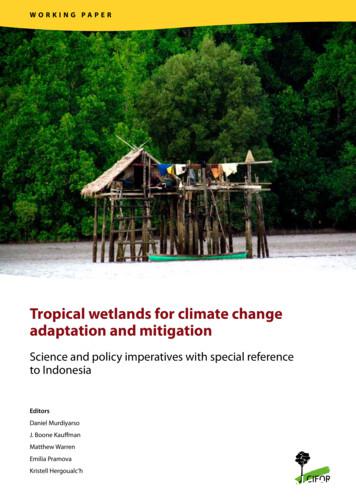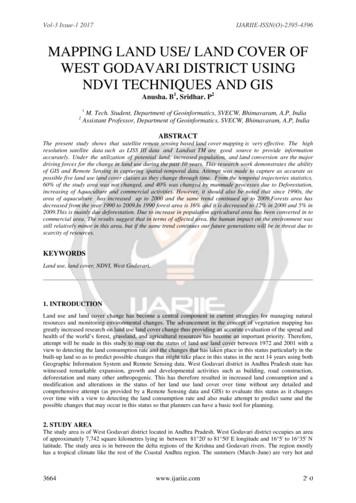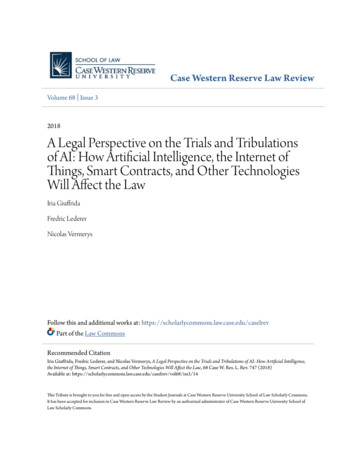Land Use/Land Cover Change Through The Applications Of
International Journal of Science, Engineering and Technology Research (IJSETR), Volume 4, Issue 9, September 2015Land Use/Land Cover Change through theApplications of GIS & Remote Sensing inblocks of Mahendragarh district of NCR,HaryanaM.P. Sharma, Ravindra Prawasi, T. P. Babu, Om Pal, R.S.Hooda Abstract— Land use/ land cover change has become acentral component in current strategies for managingnatural resources of a region. Urban expansion hasbrought losses of agriculture land, vegetation and waterbodies. Remote Sensing and Geographic InformationSystem (GIS) are vital tools for monitoring the fast landuse changes. The present study demonstrates the use ofIRS-Resourcesat-2 (LISS-III) data and GIS for landuse/land cover change analysis of Mahendargarh districtin Haryana. The data was interpretated using hybridapproach for mapping various land use/land covercategories on 1:50,000 scale for the years 2005-2006 and2011-2012. The land use/land cover classes in the studyarea are divided into six categories. The present studyrevealed that good Agricultural Land in the districtwhich has been reduced from 1621.97 sq.km. to 1568.91sq.km. from 2005-06 to 2011-2012. Most of the area hasshifted into built up due to fast urbanization. It issuggested that the industrialization and urbanizationshould be restricted to wasteland or unproductive lands.The findings and spatial data generated in the study maybe used for land use planning of the Mahendragarhdistrict.Keywords — Remote sensing, GIS, Land use/landcover, Resourcesat-2, LISS-III, change detection NCR.I.INTRODUCTIONLand use/land cover (LU/LC) changes are affectedby human intervention and natural phenomena suchas agriculture, population growth, consumption,patterns, urbanization, economic development etc.As a consequence, timely and precise informationabout (LU/LC) change detection of the area ofinterest is extremely important for understandingrelationships and interactions between human andnatural resources for better decision making.Information on land use/land cover and possibilitiesManuscript received Aug, 2015.M.P.Sharma, Haryana Space Applications Centre, CCS a Prawasi, Haryana Space Applications Centre, CCS HAUCampus, Hisar 125004(Haryana) Hisar, India;T.P.Babu, Haryana Space Applications Centre, CCS HAUCampus,Hisar,125004(Haryana)Hisar,India;Om Pal, Haryana Space Applications Centre, CCS HAU Campus,Hisar,125004(Haryana)Hisar,India;R.S.Hooda, Haryana Space Applications Centre, CCS HAUCampus, Hisar,125004(Haryana)Hisar,India;for their optimal use is essential for the selection,planning and implementation of land use schemesto meet the increasing demands for basic humanneeds and welfare. Remote Sensing (RS) andGeographic Information System (GIS) technologyhas are now the new tools for monitoring land usechanges. The Urban planners formulated 1962 theconcept of National Capital Region (NCR) in thefirst Master Plan of Delhi in 1962. The mainobjective of creation of NCR was to decongestDelhi by diffusing the population pressure towardsring towns. Thereafter, the NCR came intoexistence in 1985, when some surrounding districtsof neighboring states became part of it. This planhas to achieve its objectives through an inter-relatedpolicy framework in context to socio-economicdevelopment and environmental parameters such asthe population re-distribution, settlement patterns,regional land use / land cover patterns, economicactivities, infrastructural facilities etc. So, the NCRcomprises by the National Capital Territory (NCT)and the delineated area of the surrounding states ofHaryana, Uttar Pradesh, and Rajasthan. The landuse / land cover patterns are changing fast in the(NCR) over the period. Mahendragarh town fallingin the Haryana which is a part of NCR has gainednational recognition in the last few years due to fastgrowing service sector. Therefore, it has witnessedfast land use / land cover changes in recent times.This is one of the important factors for selectingMahendragarh for this case study to have anappreciation of changing land use patterns in NCR.This present study has been under taken with anobjective to generate spatial database on landuse/land cover for the years 2005-06 and 2011-12and to identify the pattern of (LU/LC).II. STUDY AREAMahendragarh in Haryana is bounded by Bhiwani andRohtak districts on north, by Rewari district andAlwar district on east, by Alwar, Jaipur and Sikardistricts of Rajasthan on south, and by Sikar andJhunjhunu districts of Rajasthan on the west. It is Hotin summer. Mahendargarh District summer highest2993ISSN: 2278 – 7798All Rights Reserved 2015 IJSETR
International Journal of Science, Engineering and Technology Research (IJSETR), Volume 4, Issue 9, September 2015day temperature is in between 23 C to 45 C. Mahendragarh, district in the north of HaryanaState is located between 27 0'47"N to 28 0'26"Nlatitude and 75 0'56"E to76 0'51"E longitude. Totalgeographical area (TGA) of the district is 1899 sq.km.The district is subdivided into five developmentblocks namely Ateli Mandi, Kanina Khas,Mahendargarh, Nagal Choudhary and Narnaul.III.MATERIALS AND S-P6) LISS-III data of October-20,March-31 and June 11 & 28 for Kharif, Rabi and Zaidseasons respectively prepare were used to analyze thechanges in land use/land cover map of theMahendragarh district for the three seasons data. Thesensor provides 23.5 m spatial resolution in Green,Red, NIR and SWIR bands with 24 days revisit period.3.1 ANCILLARY DATAIn the preparation of land use / land cover map theancillary data in the form of topographic maps, andother published relevant material were used asreference data. Survey of India digital topographicmaps on 1: 50,000 scale were also used foridentification of base features and for planning grounddata collection. Legacy data on land use/land cover;wastelands generated for 2008-09 were also used as areference during delineation of various wastelandclasses. ERDAS Imagine 9.3 software was used inimporting, image rectification and Geo-referencing,Arc GIS 10.0was used for digitization, preparation ofland use/land covers layer and creation of databaseand MS Office was used for database preparation.3.2 METHODOLOGYThe methodology followed was on-screen visualinterpretation using interpretation keys like tone,texture, shape, size, pattern and association, etc.Methodology flow chart provided in Fig. 1 indicatedifferent steps followed in the updation of land use/land cover map of 2005 -06 using three seasons(Kharif / Rabi /Zaid) satellite data of 2011-12 leadingto preparation of Land use/Land Cover (LU/LC) map2011-12 and also the Land use/Land Cover (LU/LC)change detection map generation.Map 1: Location Map of Study AreaClass LULC Vector of 2005-06ModifySATELLITE DATA LISS-III(2011-12)Overlay on 3 season satellite Image(2011-12)On Screen Visual InterpretationDecrease of LUCategoryIncrease of LUCategoryChange from oneclass to another classGround Truth LULC AreaGeodatabase finalizationLULC change vectorLULC map of 2011-12LULC Area TablesLULC Change MatrixMap CompositionFig. 1 - Methodology flow chart for land use/landcovers and change detection.3.3 LAND USE/LAND COVER (LU/LC)CHANGE ANALYSISLand use/ Land cover change analysis was done bycomputing the Relative Deviation (RD) of differentland use categories from the year 2005-06to 2011-12.%RD A (2011-12) - B (2005-06) x 100B (2005-06)Where: A (2011-12) is the area under a specified landuse class for the year 2011-12.B (2005-06) is the area under the same land use classfor the year 2005-06.
International Journal of Science, Engineering and Technology Research (IJSETR), Volume 4, Issue 9, September 2015III.RESULT AND DISCUSSIONFollowing results have been concluded on the basis ofthe land use/ land cover maps prepared for the twodifferent years using multi-date satellite data i.e.2005-06 and 2011-12. The distribution of land use/land cover classes in the study area in 2005-06 and2011-12 (Map 3 & 4) is represented in Table 1.CategoriesAgriculturalLandBuilt S-III Data 2005-06Area occupied in% of Area occupied(sq.km.)LISS-III Data 2011-12Area occupied in% of Area occupied(sq.km.)RD % from 2005-06to .2818991001899100Table1: Statistics of land use / land cover (LU/ LC)change in Mahendargarh district during2005-06 to 2011-12.Map 4: Land use/land cover Blockwise map ofMahendragarh district during 2011-12.Map 3: Land use/land cover Blockwise map ofMahendragarh district during 2005-06.2995ISSN: 2278 – 7798All Rights Reserved 2015 IJSETR
International Journal of Science, Engineering and Technology Research (IJSETR), Volume 4, Issue 9, September 2015% Area Occupied of 2005-062.33%0.60%8.93%0.32%Agricultural Land2.41%Built UpForest85.41%WastelandsGrass/GrazingWater bodiesFig. 2 (A) Land use/land cover area % in Mahendragarhdistrict in 2005-06.% Area Occupied of 2011-12Map 5. Land use/land cover Blockwise change inMahendragarh distict from 2005-06 to 2011-12.2.08%1.77%4.47%8.57%0.51%Agricultural LandBuilt UpForest82.60%WastelandsGrass/GrazingWater bodiesFig. 2 (B) Land use/land cover area % in Mahendragarhdistrict in 2011-12.IV.RESULT AND DISCUSSIONFollowing results have been concluded on the basis of theland use/ land cover maps prepared for the two different yearsusing multi-date satellite data i.e. 2005-06 and 2011-12. Thedistribution of land use/ land cover classes in the study area in2005-06 and 2011-12 (Fig.5A &5B) is represented in Table1.2996ISSN: 2278 – 7798All Rights Reserved 2015 IJSETR
International Journal of Science, Engineering and Technology Research (IJSETR), Volume 4, Issue 9, September 2015S.NoCategoriesAteli MandiKanina KhasMahendragarh2005-06 Area in(Sq.km.)NangalChoudhary2011-12 Areain (Sq.km.)2005-06 Areain (Sq.km.)2011-12 Areain (Sq.km.)Narnaul2005-06 Areain ture Wastelands8.178.115.795.5963.696.Water 74.00320.00Table No. 2. Statistics of land use/land cover (LU/LC) Blockwise change in of Mahendragarh district during 2005-06 to2011-12 (Area in sq.km)and the minimum area of this category isMahendragarh block i.e. 0.45 sq.km.4.1 Built Up - In Mahendragarh district the builtup area among the blocks of Mahendragarh, themaximum area under buit-up category wasKanina Khas block that is 17.19 sq.km and theminimum area of this category is Mahendragarhblock i.e. 6.80 sq.km.4.2 Agricultural area - In Mahendragarh districtthe Agricultural area among the blocks ofMahendragarh, the maximum area underAgricultural category is Narnaul block i.e. 474.70sq. km and the minimum area of this category isKanina Khas block i.e. 283.58sq.km.4.3 Water bodies - In Mahendragarh district theWater bodies among the blocks of Mahendragarh,the maximum area under Water bodies category isNangal Chaudhary block i.e. 1.78 sq. km and theminimum area of this category is Narnaul block i.e.0.37 sq.km.4.4Wasteland - In Mahendragarh district theWasteland among the blocks of Mahendragarh, themaximum area under Wasteland category is Narnaulblock i.e. 63.69 sq.km and the minimum area of thiscategory was Nangal Chaudhary block i.e. 5.59sq.km.4.5 Forest - In Mahendragarh district the Forest amongthe blocks of Mahendragarh, the maximum area underForest category is Kanina Khas block i.e. 6.70 sq.km4.6 Grazing land - In Mahendragarh district theGrazing land among the blocks of Mahendragarh,the maximum area under Grazing land category isMahendragarh block that is 13.14 sq.km and theminimum area of this category was Kanina Khasi.e. 5.58 sq.km.V. CONCLUSIONThe study shows that there has been a dynamic change inthe land use/land cover in Mahendragarh district from2005-2006 to 2011-2012. These changes may likely to alterthe structure, function and complexity of the local ecology.The urban area increased due to migration of people andindustrialization. There is need of scientific land use planningin the district due to high urban growth because of falling thedistrict in National Capital Region. Mainly agricultural area,grazing land and wasteland categories have been convertedinto built-up area during this period. The methodologyprotocol adapted for identification and delineation of eachclass using standard image interpretation techniques andinterpretation keys have played a decisive role in generatingthe area estimates.2997ISSN: 2278 – 7798All Rights Reserved 2015 IJSETR
International Journal of Science, Engineering and Technology Research (IJSETR), Volume 4, Issue 9, September 2015VI. REFERENCES[1]Abu Kubi, M., Jerusalem (ARIJ), Bethlehem, Palestine Detection andmapping of the land use/land cover (LULC) changes in the ―JordanValley‖ using LANDSAT imageries. Environmental monitoring in theSouth-Eastern Mediterranean region using RS/GIS techniques. ChaniaCIHEAM.pp: 69-84, 2003.[2]Biswajit, Majumder, ―Land Use /Land Cover change detection studyat Sukinda valley using remote sensing and GIS, Department OfMining Engineering National Institute of Technology Rourkela. pp:1-21, 2010-11.[3]U. Malmberg, and M. Metria, ―BALANS Land Cover and Land UseClassificationMethodology.Stockholm: Environment and ClimateProgramme Area 3.3: Centre for Earth Observation, UNEP, 2001.[4]P. Robbins Interrogating land covers categories: metaphor and method.Remote Sensing, Cartography and Geographic Information Science,(2001).[5]Y. Babykalpana, Classification of LULC change detection usingremotely sensed data for Coimbatore city, Tamilnadu (INDIA). AnnaUniversity, Coimbatore, India. Journal Of Computing, Vol 2, issue 5.pp: 150-157, 2010.[6]V. Singh, Land Use Mapping Using Remote Sensing & GISTechniques in Naina - Gorma Basin, Part of Rewa District, M.P., India.Journal of Emerging Technology and Advanced Engineering, Volume2, Issue 11, 2011.M.Usha. Landuse Change Detection through Image Processing andRemote Sensing Approach: A Case Study of Palladam Taluk,TamilNadu. International Journal of Engineering Research and Applications,Vol. 2, Issue 4, pp.289-294, 2012.[7][8]Ravindra Prawasi, M.P. Sharma, T.P. Babu, Om Pal, Kirti yadav, Sarojand R.S. Hooda (May-2015). Landuse/Landcover mapping andChange Deduction of Jind District using Multi Temporal SatelliteData. Published in (IJSETR), Vol 4 Issue 5, 1584-1588, May, 2015.(ISSN: 2278 – 7798.)[9]Ravindra Prawasi, M.P. Sharma, T.P. Babu, Om Pal, Kirti yadav, Sarojand R.S. Hooda (June-2015).Land Use / Land Cover Mapping andChange Detection through Remote Sensing and GIS, Block LevelStudy, Jind District, Haryana. Published in (IJCRCST), Vol 1 Issue 3,June, 2015. (ISSN: 2395 – 5325.)2998ISSN: 2278 – 7798All Rights Reserved 2015 IJSETR
the land use/ land cover maps prepared for the two different years using multi-date satellite data i.e. 2005-06 and 2011-12. The distribution of land use/ land cover classes in the study area in 2005-06 and 2011-12 (Map 3 & 4) is represented in Table 1. Table1: Statistics of land use / land cover
2005). On the other hand, land cover as a concept, is used to describe the actual land mass of the area covered by different land use types. And a change in land cover means a change that is brought about by the different land use forms within a geographic space. Two concepts of change occur on space: conversion and modification.
The variety of land use and land cover data needs is exceedingly broad. Current land use and land cov er data are needed for equalization of tax assess ments in many States. Land use and land cover data also are needed by Federal, State, and local agencies for water-resource inventory, flood control, water Cited by: 4883Publish Year: 1976Author: James R. Anderson, Ernest E. Hardy,
3 Ecosystem carbon stocks and land-use and land-cover change in tropical wetlands 10 3.1 Background 10 3.2 Land-use change 11 3.3 Carbon stock changes associated with land-use changes 12 3.4 Knowledge gaps 12 3.5 Challenges to carbon stock and land-use and land-cover change assessment 13 3.6 Emerging issues and recommendations 14
2. Land Use and Land Cover Techniques A modern nation, as a modern business, must have adequate information on many complex interrelated aspects of its activities in order to make decisions. Land use is only one such aspect, but knowledge about land use and land cover
four metropolitan regions: Accra, Kumasi, Sekondi-Takoradi, and Tamale. Deforestation as a factor of land cover change has been validated by numerous researchers (Yemefack, 2005; Angelsen, 1991; Sader, 1988). However, understanding the process of land use and land cover change is significant in foreseeing the degree of future
Land use and land cover change has become a central component in current strategies for managing natural resources and monitoring environmental changes. The advancement in the concept of vegetation mapping has greatly increased research on land use land cover chang
land use and land cover changes occurring in Kilifi County in the period between 1990 and 2014; to establish the effects of land use and land cover change on surface runoff and infiltration capacities and to generate
panied by legal questions.2 We believe that our modern high-technology era will be faced by an unusual number of such questions growing out of what we will undoubtedly term, “artificial intelligence” (“AI”), but which in fact is the combination of advanced algorithms, important pools of data, usually referred to as “big data,” and the many technol-ogies that exploit these. Some .























